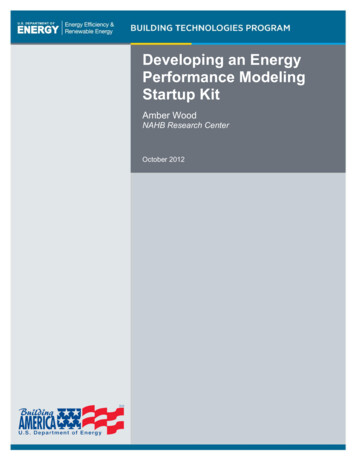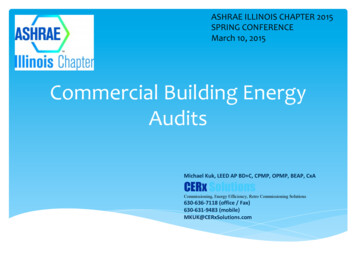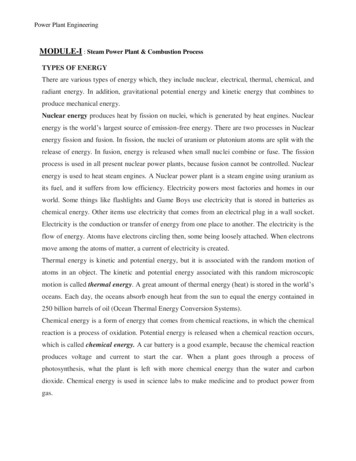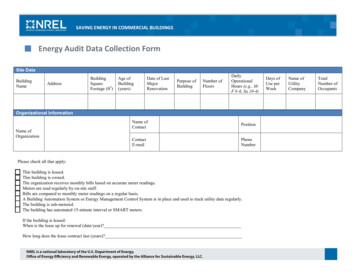
Transcription
Developing an EnergyPerformance ModelingStartup KitAmber WoodNAHB Research CenterOctober 2012
NOTICEThis report was prepared as an account of work sponsored by an agency of theUnited States government. Neither the United States government nor any agencythereof, nor any of their employees, subcontractors, or affiliated partners makes anywarranty, express or implied, or assumes any legal liability or responsibility for theaccuracy, completeness, or usefulness of any information, apparatus, product, orprocess disclosed, or represents that its use would not infringe privately owned rights.Reference herein to any specific commercial product, process, or service by tradename, trademark, manufacturer, or otherwise does not necessarily constitute or implyits endorsement, recommendation, or favoring by the United States government orany agency thereof. The views and opinions of authors expressed herein do notnecessarily state or reflect those of the United States government or any agencythereof.Available electronically at http://www.osti.gov/bridgeAvailable for a processing fee to U.S. Department of Energyand its contractors, in paper, from:U.S. Department of EnergyOffice of Scientific and Technical InformationP.O. Box 62Oak Ridge, TN 37831-0062phone: 865.576.8401fax: 865.576.5728email: mailto:reports@adonis.osti.govAvailable for sale to the public, in paper, from:U.S. Department of CommerceNational Technical Information Service5285 Port Royal RoadSpringfield, VA 22161phone: 800.553.6847fax: 703.605.6900email: orders@ntis.fedworld.govonline ordering: http://www.ntis.gov/ordering.htmPrinted on paper containing at least 50% wastepaper, including 20% postconsumer waste
Developing an Energy Performance Modeling Startup KitPrepared for:The National Renewable Energy LaboratoryOn behalf of the U.S. Department of Energy’s Building America ProgramOffice of Energy Efficiency and Renewable Energy15013 Denver West ParkwayGolden, CO 80401NREL Contract No. DE-AC36-08GO28308Prepared by:Amber WoodNAHB Research Center400 Prince George’s BoulevardUpper Marlboro, MD 20774NREL Technical Monitor: Stacey RothgebPrepared under Subcontract No. KNDJ-0-40335-00September 2012iii
[This page left blank]iv
ContentsList of Tables . viExecutive Summary . vii1 Introduction . 12 Remodelers’ View of Current Industry and Energy Efficiency . 23 Remodelers’ Gaps and Barriers to Adding Energy Efficiency into Remodeling . 44 Remodelers’ Needs for Improving Home Energy Efficiency . 7Appendix AQualitative Market Research―Understanding Remodeling and Energy EfficiencyUpgrades (initial set of remodeler focus groups) . 10Appendix BQualitative Market Research―Energy Efficient Upgrades in RemodelingExploration of Gaps and Potential Solutions (second set of remodeler focus groups) . 43Appendix CQuantitative Market Research―Building America Remodelers Start-Up Kit(quantitative market research with remodelers based on the focus groups) . 64v
List of TablesTable 1. Client Attitudes Toward Energy Efficiency Upgrades . 7Table 2. Company Approaches to Energy Efficiency Upgrades . 7Table 3. Issues Important to Remodelers . 9All tables were created by the NAHBRC team.vi
Executive SummaryThe U.S. Department of Energy’s Building America (BA) Program is a research anddevelopment program to improve the energy performance of new and existing homes. BA’sultimate goal is to achieve examples of cost-effective, energy-efficient solutions for all U.S.climate zones. This goal will be met using a whole-house system engineering approach and byuniting segments of the industry that traditionally work independently of one another, includingarchitects, engineers, builders, remodelers, trade contractors, manufacturers, material suppliers,community planners, and mortgage lenders.As a BA team, the NAHB Research Center Industry Partnership has a significant research focuson high performing existing homes. The goals for this work include addressing technologysolutions and whole-house packages, considering implementation tools to foster adoption of BAbest practices, and helping to hasten the growth of the energy retrofit market. Technologysolutions are important, but one significant gap for existing home energy performanceremodeling is business models. In this context the practices of business management,deployment, risk management, and motivation associated with potential growth and profit driveremodeling and hold the promise of a sustainable energy retrofit industry.The NAHB Research Center Industry Team’s strategic approach for this project is to identifybusiness models for the remodeling industry that foster remodelers’ adoption of energyefficiency services. Remodeling contractors often need additional technical, marketing, and otherresources to successfully provide energy upgrades to their customers. The ultimate goal is todevelop and assemble a set of operating and marketing guidelines and resources for remodelers,similar to the business startup kit, to increase their likelihood for success in expanding theircurrent services to include a comprehensive menu of energy upgrade options.This is a multiyear effort. The major tasks include: Assess the needs and motivations of residential remodelers. Assess the needs and motivations of homeowners. Develop energy performance remodeling startup guidelines, tools, and centralinformation resources. Outreach.vii
1IntroductionIn 2011, the NAHB Research Center began the first part of the multiyear effort by assessing theneeds and motivations of residential remodelers about energy performance remodeling. For thiswork, energy efficiency was defined as either a whole-house gut rehab (remodel) or above-codemeasures enhancing the energy efficiency of the existing home. The scope is multifaceted—allperspectives will be sought related to remodeling firms ranging in size from small-scale, soleproprietor to national. This will allow the Research Center to gain a deeper understanding of theremodeling and energy retrofit business and the needs of contractors when offering energyupgrade services.The research questions to assess the needs and motivations of residential remodelers forultimately developing an energy performance remodeling startup kit include: What business models have worked and failed for remodelers in the energy improvementservices market? What are the known untapped markets and ideas for accessing them? What are the current barriers and solutions for overcoming these obstacles? What are the gaps and challenges to entering the market and sustaining a marketpresence?To determine the gaps and the motivation for energy performance remodeling, the NAHBResearch Center conducted (1) an initial series of focus groups with remodelers at the 2011International Builders’ Show; (2) a second series of focus groups with remodelers at the NAHBResearch Center in conjunction with the NAHB Spring Board meeting in Washington, D.C.; and(3) quantitative market research with remodelers based on the findings from the focus groups.Three goals ensued: Understand the current remodeling industry and the role of energy efficiency. Identify the gaps and barriers to adding energy efficiency into remodeling. Quantify and prioritize the support needs of professional remodelers to increase sales andprojects involving improving home energy efficiency.This report will outline all three tasks with remodelers.1
2Remodelers’ View of Current Industry and Energy EfficiencyThe first step was to conduct three focus groups with remodelers at the 2011 InternationalBuilders’ Show in Orlando, Florida, in January 2011 to understand the current remodelingindustry and the role of energy efficiency. The purpose was to explore perspectives and practicesrelated to energy efficiency upgrades in the remodeling business to identify ways to helpremodelers successfully increase sales of energy efficiency upgrades. The objectives were togain a better understanding of the remodeling business, determine various approaches to energyefficiency upgrades and retrofits, and identify tools that could help remodelers and contractorsposition and sell energy efficiency upgrades. Results will be used to develop quantitativeresearch.The conclusions of the three groups about the current remodeling industry included: The slowdown in new construction and economic climate has shifted to greater focuson existing homes and remodeling.o More consumers are staying in their homes and deciding to upgrade, and manybuilders are turning to remodeling work to supplement their businesses.o The lending restrictions, lack of appraisal value on energy efficiency upgrades,and the flood of individuals into the remodeling arena have created a verycompetitive, price-sensitive market. Qualified remodelers and builders strive to differentiate themselves based onexperience, knowledge, and customer service, in addition to quality buildingpractices.o Anything that can help differentiate them from the “hacks” and convey to theconsumer the value an experienced, qualified remodeler or builder brings to thetable would be appreciated.o Any tools provided should help position the remodeler or builder as the expertand build trust and confidence among consumers.The conclusions of the three groups about the role of energy efficiency in the remodelingindustry included: Information sources that remodelers/builders could use to demonstrate return oninvestment (ROI) or provide a cost/benefit analysis for energy efficiency upgradeswould be valued.o Include an energy audit that assesses current energy consumption and lifestyle.o Demonstrate to consumers the potential savings or “payback” they could realize ifthey make various upgrades; connect the dots in terms of upgrades and real-worldbenefits.2
Finally, educate remodelers and builders about best practices and approaches andhelp to motivate.o Remodelers and builders who have conviction that energy efficiency upgrades are“the right way to build” tend to have more success implementing the upgrades.Their approach comes across as a knowledgeable recommendation with theconsumer’s best interest in mind rather than a sales attempt with the remodeler’sor builder’s financial interest in mind.The complete key point summary report to understand the current remodeling industry and therole of energy efficiency is included in Appendix A.3
3Remodelers’ Gaps and Barriers to Adding Energy Efficiencyinto RemodelingThe next step was to further identify the gaps and barriers to adding energy efficiency intoremodeling through two focus groups with remodelers at the NAHB Research Center inconjunction with the NAHB Spring Board meeting. The purpose was to explore current practicesrelated to energy efficiency upgrades in the remodeling business to identify ways to helpremodelers successfully increase sales of energy efficiency upgrades. Results will be used todevelop quantitative research. The objective was to build on the previous focus groups to furtherdetail the gaps and specific solutions for adding energy efficiency upgrades to remodelingincluding tools to sell the upgrades to homeowners.The conclusions of the two groups about the gaps and barriers to adding energy efficiency intoremodeling included: Most remodelers believe there is definite growth potential for energy efficiencyupgrades; however, long-term success depends on upgrades becoming marketdriven.o Incentives that are based on improved home performance rather than specificproducts will have greater long-term benefit because they broaden perspectives.o Shifting homeowner mindsets to “performance” of the home helps them tounderstand the value of making energy efficiency upgrades beyond the scope oftheir remodeling projects. There are several points of frustration for remodelers:o Perhaps the greatest source of frustration is that homeowners do not perceive thevalue of doing energy efficiency upgrades.o It is difficult to teach homeowners to think in terms of the home’s energyefficiency performance when they are focused on one specific area of the homefor the remodeling project.o Cost barriers are also a pain point. Many homeowners do not want to spend money on blower door tests orenergy audits. Remodelers believe, however, that results of the audits andtests would demonstrate problems to homeowners. Because costs are typically out of pocket for homeowners, they may notbe able to afford the energy efficiency upgrades, or they may cut theenergy efficiency upgrades from their budget in favor of aestheticupgrades. The monthly energy bill savings may not be worth the upgradeinvestments to homeowners.4
Energy efficiency improvements do not add appraisal value to the home;therefore, the improvements are viewed as a cost and homeowners lookingto sell are not motivated to make the improvements.Homeowners need to perceive a “reason why” they should invest in the upgrades.o Motivators and hot buttons will vary; however, remodelers can identify pathwaysto positioning the upgrades by listening for cues and by asking homeownersspecific questions during the beginning phases of the project.o Predominant motivators for making the upgrades tend to be: Reducing monthly energy bills. Having more predictable energy bills each month. Being able to maintain more even and/or comfortable temperatures withinthe home. Improving indoor air quality.o Some homeowners are motivated by being more environmentally responsible(e.g. living green) and contributing to the conservation of our nation’s resources.o Helping homeowners to connect the dots between a problem and solutions isnecessary for buy in. Remodelers don’t want to come across as “selling” but rather as recommendingsolutions that will benefit the homeowner.o Equipping remodelers with key questions to ask, as well as key facts, can enablethem to position themselves as knowledgeable professionals.o Educational information regarding energy inefficiency and its implications canhelp to create awareness among homeowners that there are issues that could beimproved. Ex: Did you know that you could be paying 10 – 20% more than youshould be in monthly energy costs because of leaky ducts, drafts, outdatedheating & cooling systems or insufficient insulation?o Industry information from a 3rd party source (e.g. Department of Energy, NAHB,etc.) adds credibility. Energy saving tip sheets or “Did You Know?” informationalpieces that remodelers could give homeowners would help to create receptivity,and to build confidence in the remodeler. Most remodelers agreed that the most beneficial things for stimulating growth ofenergy efficient upgrades would include:o Development of an Energy Performance Scores rating system for existing homes,which is implemented nationwide.o Establishing appraisal value for energy efficient upgrades.5
o Realtor education as to value energy efficient upgrades bring, and how to sell thefeatures.o Points off mortgage interest for energy efficient upgrades. For remodelers, the following “tools” would be of value:o Informational/educational resources to shift consumer thinking to homeperformance, increase understanding of problems, understand benefits of varioustypes of upgrades, etc. Website, DVD, printed materialso Consumer campaign to increase awareness and understanding of the value ofenergy efficient upgrades (done by government, utilities, etc.).o Free/low cost energy audits for homeowners.o Key questions to ask in order to identify opportunities, position benefits tohomeowners.o Means of quantifying impact of energy efficient upgrades (e.g. pre/post testing,energy savings calculators, etc.).o Connecting remodelers with energy auditors so they can develop a referralnetwork.The complete key point summary report to further identify the gaps and barriers to adding energyefficiency into remodeling is included in Appendix B.6
4Remodelers’ Needs for Improving Home Energy EfficiencyThe final step was to quantify and prioritize the support needs of professional remodelers toincrease sales and projects involving improving home energy efficiency. This was addressedthrough quantitative market research with remodelers. This phase of the research builds upon thequalitative remodeler focus groups, conducted at IBS and at the NAHB Research Center, toquantify and prioritize the support needs of professional remodelers to increase sales and projectsinvolving improving home energy efficiency.The qualitative market research included a total of 160 respondents. Key questions and theresearch results included:What percentage of your recent clients fit into the following groups when it comes toaccepting energy efficient upgrades? According to remodelers, 21% of their clients activelyseek energy efficiency upgrades during a home remodeling project. Another 39% said theirclients are open to the idea of energy efficiency upgrades (Table 1).Table 1. Client Attitudes Toward Energy Efficiency Upgrades% Clients in Following GroupsMeanBottom line focused—will not spend any more than they have to.40%Can be convinced—may or may not think about energy efficiency,but are open to the upgrades once they understand the benefits.39%Embraces, or actively seeks, energy efficiency.21%Total100%When working with clients, which of the following statements most closely describes yourcompany’s approach to energy efficient upgrades? Forty-three percent of remodelers follow theapproach of incorporating energy efficiency into as many jobs as possible (Table 2).Table 2. Company Approaches to Energy Efficiency UpgradesCompany Approach to Energy Efficient UpgradesWe do not try to sell or offer energy efficient upgrades unless theyare specifically asked for by the client.Frequency6%We offer or recommend it when the energy efficient upgrade is costeffective and is directly related to the home improvement project.51%We believe energy efficient upgrades are part of “doing it the rightway” and incorporate this into as many remodeling jobs as possible.43%Total100%7
What is the relative importance of all of the issues (see Table 3)?o Remodelers believe their biggest obstacle to selling energy efficiency upgrades isthat appraisal values factor into what types of remodels clients are willing toundertake.o Other major obstacles include: clients unable to discern between high and lowquality construction in the bidding phase; Realtors are not able to describe thevalue of energy efficiency; Difficulty in comparing existing homes on theirenergy efficiency; and that homeowners want to see tangible differences after aremodel, making it difficult to sell energy efficiency.o The top 10 issues are included in Table 3. The complete Start-Up Kit RemodelersQuantitative Market Research Results Overview report to quantify and prioritizethe support needs of professional remodelers to increase sales and projectsinvolving improving home energy efficiency is included in Appendix C.8
Table 3. Issues Important to RemodelersPriority1Issues Sorted by Importance to RemodelersAppraisal values factor into what type of remodels clients are willing toundertake, and energy efficiency is difficult to value.2Clients are typically unable to discern between high quality and lowquality construction at the bidding phase. Often they select the lowestcost bidder. This makes selling upgraded energy efficiency difficult.3Realtors, who are in contact with homeowners as they buy/sell homes,aren’t able to describe the value of energy efficiency.4There is no standard way to compare a home’s energy efficiency whenbuying or selling an existing home.5Homeowners want to see tangible differences, often focusing onaesthetics or functionality, which makes energy efficiency a difficultsell.6One popular way to determine airtightness, a blower door test, isexpensive and most clients are not willing to pay for just an evaluation.7Homeowners see energy efficiency upgrade costs as an expense and notan investment.8Clients don’t understand the value of energy efficiency. They place littlevalue on it. If consumers don’t see a problem, then they won’t purchasethe solution.9There is little real demand for energy efficiency. Homeowners are justfollowing the money for rebates.10No coordinated efforts between the federal government, stategovernment, and utilities when it comes to offering, applying for, andcomplying with energy efficiency incentive programs.The next step of the multiyear project will include similar research with homeowners. Thesefindings will then be the basis for developing the Energy Remodeling “Start-up Kit” guidelinesand assembling the most relevant technical and business resources.9
Appendix AQualitative Market Research―UnderstandingRemodeling and Energy Efficiency Upgrades(initial set of remodeler focus groups)10
Understanding Remodeling Business andApproaches to Energy Efficient UpgradesQualitative ResearchKey Points Summary2011 International Builders ShowOrlando, FLPrepared for:The NAHB Research Center Industry Partnershipas part of theU.S. DOE Building America ProgramFebruary, 2011011
Objectives and MethodologyThe purpose of the research was to explore perspectives and practices related to energyefficient upgrades in the remodeling business in order to identify ways to help remodelerssuccessfully increase sales of energy efficient upgrades. Specific objectives were to: Gain a better understanding of how the remodeling business worksAssess perspectives and approaches regarding energy efficiency upgrades/retrofitsIdentify tools that could benefit remodelers/contractors in positioning and sellingenergy efficient upgrades to homeownerDiscuss within context of whole-house and partial energy efficiency upgradesThree focus group discussions were conducted among remodelers,general contractors, and custom builders at the 2011 InternationalBuilders Show. Group 1 regularly installing a lot of energy efficient upgrades (more than 3 types)Group 2 frequently/always installing energy efficient upgrades, but only 2 – 3 typesGroup 3 occasionally install energy efficient upgradesEnergy efficient upgrades screened for: Appliances Windows Insulation HVAC Solar panels Other121
Objectives and Methodology Each group consisted of eight participants who All either made or influenced the final decision for selecting building materials used intheir projectsRepresented a mix in terms of remodelers, general contractors, and custom buildersRepresented a mix in terms of title/role and geographic marketType of Business (n 24)Remodeling2Remodeling/General contracting7Remodeling/Custom new home building11Custom new home building7Participants represented 17 different states: CA, CO, DE, FL, IA, KS, MA, MD, MT, NC, NJ, NM, OR, PA, TN, TX, WANOTE: Qualitative research seeks to develop insights into attitudes, beliefs, and opinions, rather than quantify precisemeasures; therefore findings can not be reliably projected to a larger population. Results provide a betterunderstanding of perceptions and practices and should be used as directional insights.213
Summary of Key Findings314
Summary of Key FindingsOverview5Remodeling Business –Market Climate Snapshot6Understanding theRemodeling Business10Energy Efficiency:Perspectives & Practices15Energy Efficiency:Tools for Success27Conclusions30415
OverviewThe exploratory nature of the research helps to uncoveropportunities and barriers for increasing energy efficientupgradesBy exploring:Current market climateRemodeling businessstructure, approachConsumer mindsetWe can identify: What trends or shifts have been impacting theremodeling business How the current market climate influences the potentialfor energy efficient upgrades in remodels/retrofits How business structure impacts approachWhat attitudes & philosophies shape business practicesHow energy efficient upgrades are handledHow well equipped remodelers/builders feel to sellenergy efficient upgrades What consumers are looking for in their remodel Degree of receptivity to energy efficient upgrades How to connect with them to position energy efficientupgrades516
Remodeling Business –Market Climate SnapshotThe economy and decline in new home construction have impactedthe remodeling business in numerous ing theirdollarsSize and scopeof hangingConsumersseeking tangiblebenefitsRemodelers/builders are faced with a number of challenges and must find ways todifferentiate and demonstrate the value they bring to the consumer176
Remodeling Business –Market Climate SnapshotFocus on remodeling has increased among both consumersand builders Lending restrictions are stifling new home purchases; therefore, many consumers arefocused on updating their existing home Yield differentimplications forenergy efficiencyDecline in new home construction has forced many builders to downsize and/or pursuemore remodeling business Some renovate with the intent of staying in the home over a longer period of timeOthers renovate with the goal of increasing the appraisal value for resaleMany have been forced to reduce the number of employeesThe amount of remodeling projects as a proportion of their business has increased in order for them tostay afloatLayoffs within the building industry, and even other industries, have resulted in an influxof people vying for the remodeling work Climate is extremely competitiveMarket has been flooded with “hacks” who often are not well qualified and who undercut on pricePrevalence of individuals doing whatever work they can at a low price has created a dollar focus ratherthan value focus among many consumersConsumers often don’t have a good understanding of whatit takes to do a job right, so they don’t want to pay more718
Remodeling Business –Market Climate SnapshotRemodelers/builders consistently noted several challengesfaced as a result of the economic climate By far, the greatest challenge faced stems from the flood of competition for remodelingprojects Most do not mind competing against other qualified remodelers who are in the same boat; however What remodelers/builders consider to be greatly hurting the remodeling industry is the influx of “hacks”who may or may not be qualified, or even licensed, to do the work and who greatly undercut bids in orderto get the work“I’ll have a 50,000 - 60,000 kitchen job that’s a total gut, all new lighting, newappliances, and then I’ll have Joe in the pickup truck come by and say he’ll do itfor 25,000 and I’ll lose the job.” (Remodeler, NJ)Detrimental impact because: Most are not licensed and have no insurance (puts homeowner at risk)Lack of education among homeowners leads them to believe they are getting an apples toapples comparison in terms of job quality and scope, when often they are not Low bidding magnifies already existing price sensitivity and fosters a price-driven consumermindset rather than benefit and value-driven mindset “A lot of people are really just going for price now; they’re not going forquality. You can tell them all the extra energy factors and things but they’renot really concerned.” (Remodeler/GC, TN)819
Remodeling Business –Market Climate SnapshotThe type of remodeling projects are also shifting, with consumershaving to scrutinize use of their dollars more carefully The scope of work/size of remodeling jobs has diminished in many areas due toeconomic factors Many consumers are not willing to spend, or not able to get financingFor many remodelers, scope of work has shifted from whole house guts or major additions to justfocusing on the kitchen, bath or other single rooms; or instead of adding to the house, focusing more onrenovationsProjects have gone from 100,000 in scope to 30,000 - 40,000See increase in consumer mentality of “do some now, then wait and do more later” or in trade-offevaluations where other things (car, landscape, etc.) are competing with remodel for available dollarsAppraisal value shapes what some consumers are willing to invest in, which can bebarrier to selling energy efficient upgrades Lenders will not give appraisal value for energy efficient upgrades; therefore, many consumers chose tospend their dollars on “cosmetic” renovations and upgrades that will increase the resale value of theirhomeConsumers who value energy efficiency may believe it’s better to invest in a new home than to invest inupgrading their existing home920
Understanding theRemodeling BusinessThe participants have had to adjust their business focus andstructure in order to survive Many of the participants have had to reduce number of employees. As a result, some are“putting back on the toolbelt” and doing some of the work themselves For many of the participants, number of employees has declined to 3-4 or to no other employeesThe larger remodelers and custom builders have remained more stable, maintaining anywhere from 10 to20 employeesMost, but not all, use sub-contractors, particularly for specialty trades such as electrical, plumbing andHVACReasons for not using subs are primarily: Fin
Quantitative Market Research―Building America Remodelers Start-Up Kit . perspectives will be sought related to remodeling firms ranging in size from small-scale, sole . ultimately developing an energy performance remodeling startup kit include: What business models have worked and failed










